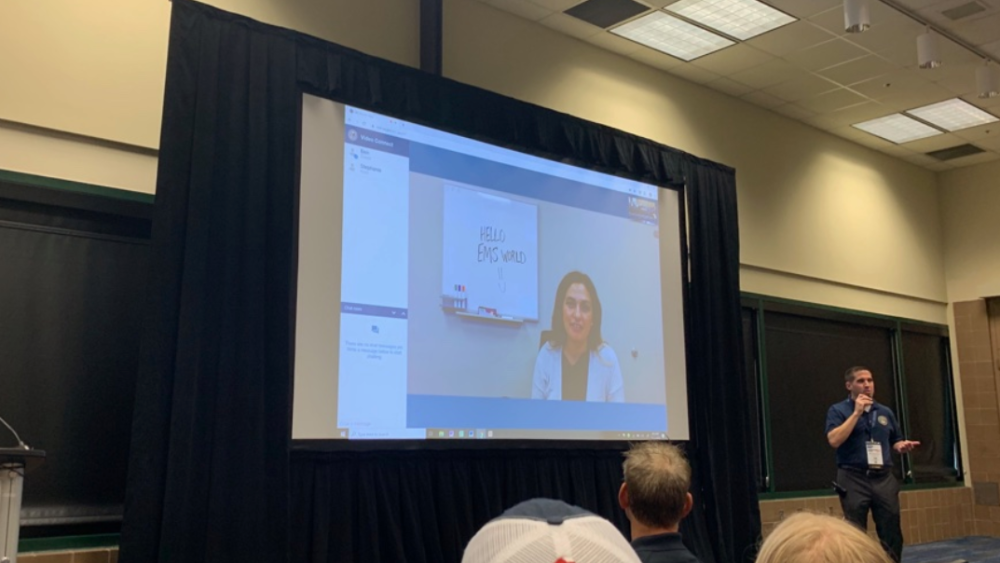Veterans have complex health needs that require specialty services and a dedicated healthcare home.
In a session at the 2019 EMS World Expo, Jason Schaak, NRP, CCP, TEMS; and Benjamin Thelen, MSN, RN, CNML, demonstrated how an EMS agency can provide comprehensive care to the veteran population within their community in a session titled, “Serving Those Who Served Our Country: How an MIH and VA Hospital Partnership Helps Veterans.”
Schaak is a captain and MIH coordinator with the West Allis (Wisconsin) Fire Department. Thelen is nurse manager with the Veterans Affairs in Fox Point, Wisconsin.
Their presentation encompassed customizing ePCRs to identify veterans and their medical homes, refer them to MIH services, and provide tele-health home visits.
Key quotes on improving veteran care with MIH/community paramedicine
Here are the most poignant quotes from Thelen and Schaak:
“Our high utilizers are very complex. When you ask them who their primary doctor is, they say ‘ERMed’ is their doctor; emergency medicine.” — Ben Thelen
“The VA has thousands of resources. There’s a huge support system for this particular population if we can connect them through mobile integrated healthcare services.” —Jason Schaak
“They’re seeing the things in the home that the veterans aren’t telling us about in the hospital and closing that gap.” —Ben Thelen
“We don’t tell them to do things; instead, we actually do it for them while we’re right there.” —Jason Schaak
Top takeaways on providing MIH/community paramedicine for veterans
Thelen and Schaak detailed the hurdles they encountered in serving veterans through the VA, and identified the benefits of veteran outreach and the provision of specialty services within a community. Here are three takeaways on serving veterans.
1. Veterans don’t call 911
The Fox Point VA found that while ED volume was increasing, EMS transport was not. “Most veterans do not call 911 to go to the hospital,” Thelen noted.
Veterans were driving themselves to the hospital while experiencing a STEMI or a stroke, or arriving pulseless and not breathing in family vehicles. One was even transported in the back of a flat-bed pickup truck. The family member behind the wheel said, “he told us never to call 911.”
After reaching out to veterans, Thelen’s team found the issue stemmed from diversion. The veterans wanted to be treated at the VA, and didn’t trust EMS to bring them there. There are no copays for imaging or labs for veterans at the VA. If they get transported to the private sector, they get socked, Thelen noted, so they were self-transporting to avoid unnecessary costs.
Why wasn’t EMS transporting them to the VA? The reason was two-fold.
-
Reputation. EMS providers weren’t familiar with the level of resources available at the VA, and didn’t know if they had the capability to care for patients.
-
Verifiable status. EMS also didn’t have any way to verify if a patient was a veteran.
Public education and outreach was vital to overcoming outdated beliefs about long wait times, unqualified ED staff and a lack of services, as the VA is now staffed with board-cetrified emergency medicine physicians, has true ED capabilities and moves a lot faster than it used to, Thelen said.
Additionally, a mailer was sent to veterans in West Allis, Wyoming, which succeeded in enrolling 2,300 veterans into the system.
2. Using technology to serve veterans’ medical needs
Three technological initiatives helped increase veteran transport to the VA and improve their service utilization.
-
Enrollment. Pre-registering the veterans into the ePCR before they called 911 meant as soon as responding EMS queried the name or address it would identify the patient as a veteran, and the VA as their medical home. Schaak noted the veteran’s status was a simple yes or no built in repeatable field in their ImageTrend software. These efforts resulted in an uptick of veteran transports to the VA – a 23% increase in West Allis. The program has been expanded to four other fire departments covering 10 municipalities.
-
Suicide screening. Suicide rates are “staggering” in the veteran population, Schaak reported, while EMS training in and recognition of suicide ideation is limited. To address this, the MIH team adopted the VA psychiatric department’s suicide ideation screen and added it into their ePCR. To implement the screening, providers ask the patient if they have ever served in the military, and then administer a basic six-question screen of very pointed questions. Any affirmative response elicits connecting the patient to appropriate services.
-
Telehealth. The VA is also pursuing telehealth across the board, making it easier for veterans to get connected care wherever they are, even if they are reluctant to visit the hospital. VA Video Connect, a free app for veterans akin to Skype, is easy to use – a link brings them to a secure room, where they can video consult with a specialist or mental health provider during scheduled MIH visits. A host of Bluetooth-enabled devices – EKG, pulse ox, stethoscope, otoscope, weights – transmit data directly to their medical records through iPads purchased for this purpose.
3. MIH lowers high-utilization and improves veterans’ quality of life
The West Allis-VA pilot program, while small, was extremely effective in reducing call volume. Thelen and Schaak noted their pilot program eliminated ED admissions for the MIH patients enrolled, with the exception of call that was unrelated to the patient’s previous complaint.
The benefit to the MIH program lies in the 1:1 interaction the community paramedics provide in the home, where they can dive into the underlying problems that impact veterans’ health. “If the veterans come into the ED, we don’t hear about the stuff going on at home,” Thelen pointed out.
They provided a few examples.
-
One patient had no idea how to use his respiratory medicines. He couldn’t walk 5 feet without being extremely out of breath and dizzy. Once the MIH team was able to get into the home, provide training and gain some traction, he asked them to assemble his shower bench – something he wouldn’t have been able to do for himself, that the medics were able to do in a matter of minutes to greatly improve his quality of life.
-
Another patient was taking his diuretic medication improperly, “doubling down” when he didn’t really need it anymore. He was frequently passing out and presenting at the ED with syncopal episodes. The MIH team identified the problem and instructed the patient to stop taking the medication, which immediately reduced his episodes.
-
Yet another patient was being treated for frequent GI issues. Once the MIH team was able to visit the home, they found the house was immaculate … with the exception of the kitchen, which “looked like a bomb went off,” Schaak recalled. They discovered the patient was bulimic and were able to connect him with the right services.
These visits take some time, Schaak told attendees. “It can take a couple hours to get to the nitty gritty.” But his team found there is usually one thing that’s causing a patient’s high ED utilization. “If we can identify that one thing and get them connected to the right resources, we can end their high utilization,” he said.
Additional resources on MIH/community paramedicine
Learn more about mobile integrated healthcare/community paramedicine with these articles from EMS1:
-
Clinician-embedded MIH program improves EMS use in high-risk population
-
Top 10 MIH or community paramedicine program funding sources
This article was originally posted Oct. 18, 2019. It has been updated.













